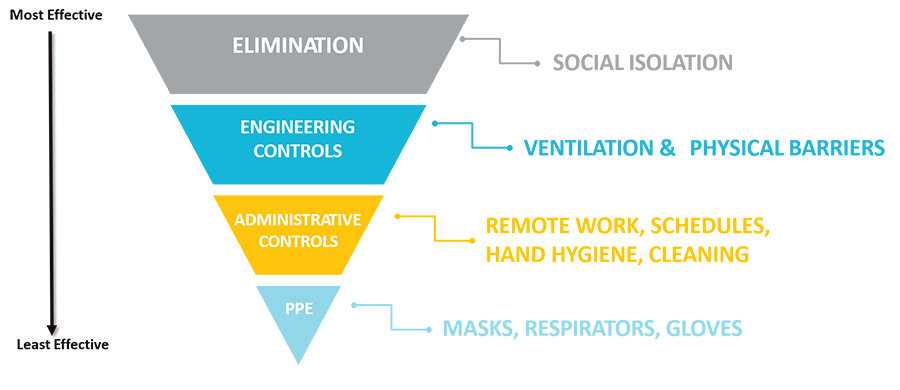Create Healthier Indoor Environments
22 Sep 2020
Practical Approaches to Reduce Risks
From employment to education to entertainment, when people enter a place, they want peace of mind that it is safe and sanitary. This is especially true in a COVID-19 and post-COVID world. The key elements to general health and wellness in buildings include air quality, water quality, thermal comfort, physical space, acoustics, and comfort. Now, as people begin to return to schools, workplaces, and public spaces, it is important to strike a balance between these elements in a way that allows for better infection control. Doing so will allow us to more safely re-occupy our spaces.
A safe restart is possible, provided it is based on established health research and new knowledge of pathogen transmission, including SARS-CoV-2 and similar viruses. Also important are general observations of COVID and similar illnesses and the guidelines and recommended practices from expert individuals and organizations. These can be used together to come up with a strategic plan for reoccupation.
For facilities that have been unoccupied for an extended period, there are several key considerations for successful restarts: air quality, water quality and moisture issues that may have developed during the shutdown. Addressing these items, is a critical first step in safe reopening. Beyond this, thoughtful consideration of the hierarchy of control strategies for COVID-19 is necessary to balance necessary risk reductions with operational practicalities.

Social isolation is highly effective at reducing transmission risks but is not compatible with many societal functions, while personal protective equipment (PPE) is helpful but not a complete solution. A combination of measures is key to returning to work, school, and other activities while limiting the spread of the virus. Risks related to illnesses like COVID-19 can be mitigated through engineering controls like air contaminant removals, ideally targeting 99 percent contaminant removal in a limited time period, while maintaining energy efficiency. This can be accomplished through a combination of dilution ventilation, sanitization (e.g. ultraviolet light), and enhanced filtration. The optimal solution for any given facility could include, one, two, or all three of these strategies.
Additional engineering controls include the use of touchless controls (e.g. restroom fixtures and door openers), physical barriers, and changes to space usage to create distancing between people. Administrative controls also play an important role and include actions such as response planning, education, and scheduling. Education should include topics like mask/glove use, hand hygiene, respiratory etiquette, health screening, and mechanisms of disease transmission, and training programs should incorporate regular message reinforcement (via signs and reminders). Training for housekeeping staff should cover effective high-touch surface sanitizing protocols, green cleaning practices and safe chemical handling and storage.
Safe re-occupancy is not the only concern. The industry must also consider how we design and manage spaces in the future. This will include creative consideration of space usage, flexible scheduling, improved ventilation system design, touchless technologies and new finishes. Whether now or in the future, it is important to understand the real risks associated with occupying shared spaces and engage a team of experts to help implement effective short- and long-term solutions. Get more insights by downloading our webinar recording.

Alan Scott,
Principal Consultant
Alan is a registered architect and sustainability expert with over 30 years of experience and a lifelong commitment to sustainability. In his early career as a practicing architect, he helped launch sustainable design practices at several major firms. Since 2000—as the 13th LEED AP—Alan has creatively applied his skills as a facilitator, consultant, project director, and teacher in support of high-performance, sustainable built environment projects across the globe. His project work focuses on boosting new and existing building performance, decarbonization, occupant wellness and resilience.